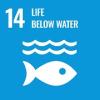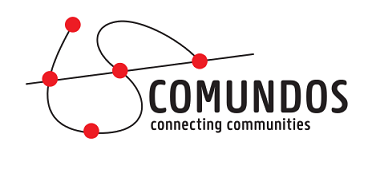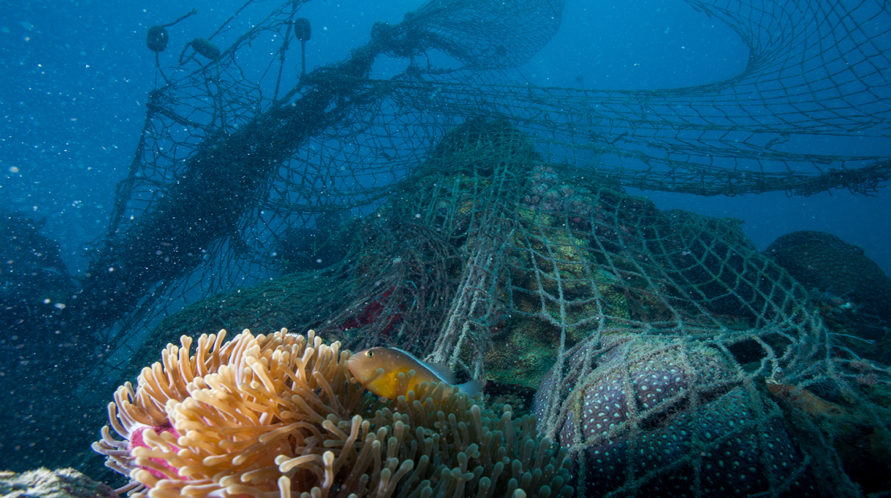SDG14 in the classroom: Life below water
“Conserve and sustainably use the oceans, seas and marine resources for sustainable development”.
At the end of the lesson, students will:
- Understand what SDG14 advocates for

- Understand how important oceans, seas and marine resources are
- Understand key terms like ocean acidification, ocean warming, oxygen loss, bycatch
- Understand the role of the fish industry and its consequences
- Analyze digital stories on SDG14
- Fabricate their own cloth shopping bag
We tend to look at the sea and oceans as uncontaminated and peaceful places. The problem is that we often don't see what's actually happening underwater. The sustainability of our oceans and seas is under severe threat. Dead zones (zones in the oceans that lack oxygen) are rising at a fast rate. But what is really happening below water? Let's find out more through the following activities.
Brainstorm session through the suggested questions.
- Oceans absorb about 30% of the carbon dioxide we humans produce. Yet, these Carbon emissions are causing ocean warming, acidification and oxygen loss. Can you explain these phenomena?
- What is damaging and polluting our oceans?
- Plastic takes about 1000 years to degrade. However, plastic doesn’t just disappear afterwards. Do you know exactly what happens to a plastic bottle after 1000 years?
- Who is most affected by plastic pollution in the oceans and seas?
- In your opinion, how does fishing happen? Do we actually need all the fish being caught?
- Do you know what “bycatch” means and causes?
- What do you think would happen below water if worldwide we stop eating fish for some time?
- Supporting small-scale fishing is one of the actions governments could take to save the oceans. What else could the governments do?
- What could you do in your daily life to help achieve this goal?
Possible adaptations: (Online)This activity can be done with the use of online tools (i.e.Jamboard; Mentimeter or Miro).
Sources to link with Activity 1.
- Will the ocean ever run out of fish? - Ayana Elizabeth Johnson and Jennifer Jacquet. This explanatory video is highly recommended as it answers all the questions suggested in the brainstorming session in a clear and easy way.
- Marine pollution (National Geographic)
- WWF explains bycatch and its causes.
- SDG 14 UN (infographic, targets and progress)
This activity can be done in groups (4 students per group) or individually.
- What is the main focus of the story?
- What is the overall message of the story?
- What would happen if more biodegradable fishing nets would be adopted worldwide?
- If biodegradable fishing nets are a possible solution to mitigate the problem, why are they not used worldwide?
 The importance of Mangroves in the Angoche District (Mozambique)
The importance of Mangroves in the Angoche District (Mozambique)
- Have you ever seen a mangrove before?
- Why are mangroves important for the ecosystem in coastal areas?
- The author is suggesting adopting a system for the replantation of mangroves to limit this problem. Do you have other solutions in mind?
You can also select other digital stories of Comundos related to SDG14
Propose students these actions:
- Encourage your family and friends to use cloth or hemp shopping bags instead of plastic ones. Explain its use and positive impacts on the oceans and environment. Stress the importance of reusing bags (even cloth ones) instead of always buying new ones.
- Why not make one of your own using an old pillowcase? If needed, ask someone who can help you make one.
A good and easy tutorial for beginners can be very helpful: How to Make a Grocery Bag from a Pillowcase.
Remember that using a cloth shopping bag isn't the final solution so try to use a reusable bottle, buy plastic-free goods, reusable straws, etc.
Possible adaptations: This activity can be assigned as homework with a deadline (i.e. 3 weeks). If time allows, the video tutorial can be watched in class to answer clarifying questions.
This work should be done individually. However, working in pairs can be suggested (peer teaching).
This quiz is about UN Goal 14: Life below water. You can either use it at the end of your lesson to revise the topics you talked about or at the beginning of the lesson to challenge students prior knowledge and gain their attention.
 For SDG14 (life below water) sheet, our favourite pedagogical twist is:
For SDG14 (life below water) sheet, our favourite pedagogical twist is:
Constructivism: Organize a trip to the seaside and let students (in small groups) explore the environment. Provide them with the initial brainstorm questions so that they can answer them while exploring and learning via interaction with the environments they are in. Both their prior knowledge, cooperative learning and exploration of the environment will help answer the questions or trigger possible answers.
If you have another pedagogical twist in mind, feel free to apply or check the pedagogical twist list.
- New Report from WWF Says Addressing Abandoned Fishing Gear Must be Central in the Fight Against Plastic Pollution.
- Sea Shepherd: For The Ocean. Sea Shepherd is an international, non-profit marine conservation organization that engages in direct action campaigns to defend wildlife, and conserve and protect the world’s oceans from illegal exploitation and environmental destruction.
- Operation Siso: Protecting the Mediterranean Sea (Sea Shepherd) shows an important operation in the Mediterranean Sea, in partnership with the Italian authorities to to find and confiscate illegal driftnets -- aka "Walls of Death" -- in the Tyrrhenian Sea's Aeolian Islands, a UNESCO heritage site.
- The targets of SDG 14.

A gift for Comundos
Over the years, Comundos has helped remote communities around the world by teaching critical thinking, media literacy and the use of communication technology.
To do this effectively, we need your support for computers, translations, courses and social media management.
Thank you .
BE11 1030 2973 8248





